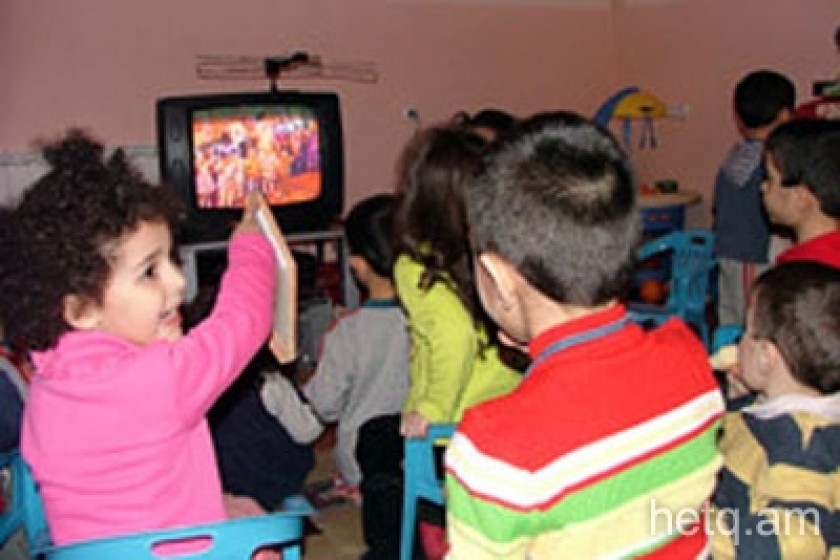
Expectation as the meaning of life
“Do you want me to dance for you?” she asks, her eyes begging me to say yes.
“No, I now have to go,” I say.
“Do you want me to sing? Or I can recite poetry.”
“Another time, OK? I really have to go now.”
“Are you going …” she stops for a moment, “home?”
She is one of 78 children at the Nork Children's Home. It's silly, but I feel guilty about going home.
“All right,” I say. “I'll stay for a while.”
She climbs onto a couch and tidies her hair.
“You are a big girl now,” she says seriously. “You have to brush your hair and tie it back.”
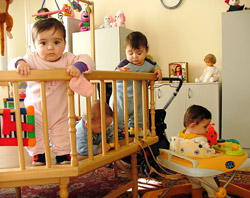 She is four or five years old. A little woman. There is no doubt about who is the boss of the other children. She doesn't let anyone get a word in, and responds in their place. She calls herself Malinka.
She is four or five years old. A little woman. There is no doubt about who is the boss of the other children. She doesn't let anyone get a word in, and responds in their place. She calls herself Malinka.
“Well, now open your eyes and you can look,” she says with satisfaction, and she and the other children drag me over to show mw their toys.
“Look, my car has remote control. My mother brought it.”
“Look what a tiny plane. It's the tiniest plane in the world. My mother brought it when she came last time.”
They have lots of different toys, but the best, the most dear to them are the ones that their mothers brought. They have tutors and nannies who love them, take care of them, scold them – just like mothers do. But all the same, they never stop waiting for their mothers.
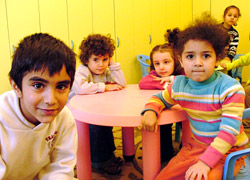 Karen has lived in the children's home for five years now. He was found in a garbage dump when he was one. His mother visits him once a year when she comes to prolong the agreement by which he says at the home. Some children mothers visit them more often, and that makes Karen feel sad. The tutors have to patiently explain to the boy that his mother is ill or is very busy, but that she certainly will visit him soon. And he believes it, and waits for her.
Karen has lived in the children's home for five years now. He was found in a garbage dump when he was one. His mother visits him once a year when she comes to prolong the agreement by which he says at the home. Some children mothers visit them more often, and that makes Karen feel sad. The tutors have to patiently explain to the boy that his mother is ill or is very busy, but that she certainly will visit him soon. And he believes it, and waits for her.
But on her last visit his mother said that he was going to be transferred to another children's home, instead of going home, since she has another baby and cannot take care of them both. According to regulations, when children turn six they are moved to other children's homes. Karen has become very attached to his nanny. And she herself loves the boy as her own and would be happy to adopt him.
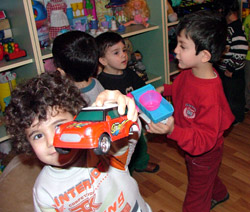 “I can't imagine what am I going to do without him,” she says tearfully. “It's like giving my own child away to strangers.”
“I can't imagine what am I going to do without him,” she says tearfully. “It's like giving my own child away to strangers.”
But the law prevents her from adopting Karen since his biological mother, who, by the way, was sentenced to six years in prison for a crime and later had her maternal rights restored, doesn't want to officially abandon the boy.
Malinka has never seen her mother. Her grandparents, both of whom are sick, brought her to the children's home. Her grandfather, who gets about on crutches, visits her a few times a year. She is constantly waiting and asks everyone, just as she asks me, “Do you want to be my mother?”
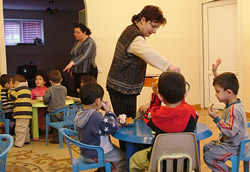 The Nork Children's Home is the only institution inArmeniathat takes children in from the moment they are born. Children can stay here until they turn six, and if no one adopts them by that time, they are transferred to other children's homes. Orphans, children with single parents and those whose parents are in prison or are undergoing medical treatment are accepted at the children's home.
The Nork Children's Home is the only institution inArmeniathat takes children in from the moment they are born. Children can stay here until they turn six, and if no one adopts them by that time, they are transferred to other children's homes. Orphans, children with single parents and those whose parents are in prison or are undergoing medical treatment are accepted at the children's home.
The home was founded in 1937. During the Soviet era there were many cases where children were found on benches in parks or in garbage dumps. Often young mothers brought their illegitimate children because their fathers or brothers told them to get rid of the “shameful” child.
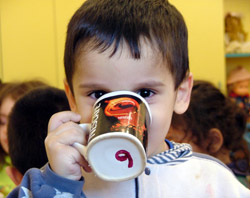 Liana Karapetyan, the director of the children's home, says that in recent years such cases have almost disappeared. Nowadays the main reasons that the mothers note in their applications are socioeconomic. 90 percent of these women have no permanent residence. Some mothers abandon their children once and for all. Others apply for temporary accommodation. The children's home allows parents who have not resigned their parental rights to visit their children every Friday. If a parent doesn't show up for a year, the children's home takes the case to court and the court decides whether or not to deprive the parent of parental rights.
Liana Karapetyan, the director of the children's home, says that in recent years such cases have almost disappeared. Nowadays the main reasons that the mothers note in their applications are socioeconomic. 90 percent of these women have no permanent residence. Some mothers abandon their children once and for all. Others apply for temporary accommodation. The children's home allows parents who have not resigned their parental rights to visit their children every Friday. If a parent doesn't show up for a year, the children's home takes the case to court and the court decides whether or not to deprive the parent of parental rights.
Annually the children's home provides services to 100 and 140 children, and accommodates up to 70 of them. The director, who has worked here for 26 years, says that there are no precise statistics regarding the number of children accepted to the children's home. In the Soviet era the state allotted apartments and subsidies to single mothers; nevertheless, there were still a fair number of abandoned children. At that time, the population ofArmeniawas bigger and there were only half the number of the children's homes that there are today (there are currently eight state and four private children's homes).
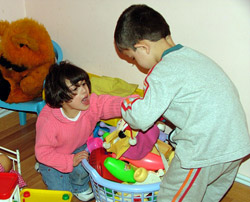 Between 20 and 25 percent of the children go back to their biological parents every year, some 20-25 percent are adopted, and some 10 percent are transferred to other children's homes.
Between 20 and 25 percent of the children go back to their biological parents every year, some 20-25 percent are adopted, and some 10 percent are transferred to other children's homes.
Nearly all eligible healthy children are adopted at an early age. The priority, of course, is given to the citizens ofArmenia, then to Diaspora-Armenians, and after that to foreigners. Foreigners are mainly able to adopt children with health problems. Only citizens of those countries whereArmeniahas diplomatic missions may adopt children.
Adoption is a lengthy and complicated process and is coupled with big risks.
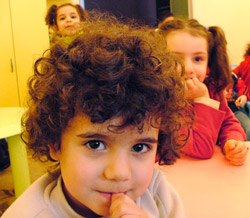 “We don't really know who these children's mothers are and how healthy they are. n her application a mother is required to note whether she is registered with a tuberculosis prevention center, dermatovenerologic dispensary, or psychiatric hospital and whether there have been cases of psychiatric disorders in her family or not, as well as to list the illnesses she has had. But we never know to what extent their answers correspond to the truth. Besides, the mother mentions only her illnesses, but there is a father as well who, in some cases, is not known even to the woman,” Liana Karapetyan says.
“We don't really know who these children's mothers are and how healthy they are. n her application a mother is required to note whether she is registered with a tuberculosis prevention center, dermatovenerologic dispensary, or psychiatric hospital and whether there have been cases of psychiatric disorders in her family or not, as well as to list the illnesses she has had. But we never know to what extent their answers correspond to the truth. Besides, the mother mentions only her illnesses, but there is a father as well who, in some cases, is not known even to the woman,” Liana Karapetyan says.
The adoptive parents can request a neurological and epidemiological examination, but that provides no guarantees. Only disorders that are manifest in the child at the moment can be identified. But schizophrenia, for example, doesn't appear until about the age of fourteen.
In such cases an adoptive parent has the right to return the child, if he or she can prove in court that there are sufficient grounds.
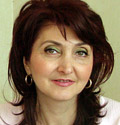 Liana Karapetyan says that in the course of the years she has been the director of the children's home there have been cases of misfortune. For example, a three-month-old boy was adopted and later on it turned out that the boy was deaf. Another child was adopted at the age of two and after a year a brain tumor was discovered. A girl adopted by American-Armenians began losing her hearing at the age of one and a half. American doctors said that since the child had been premature and had been kept in an incubator, she was likely to continue to lose her hearing.
Liana Karapetyan says that in the course of the years she has been the director of the children's home there have been cases of misfortune. For example, a three-month-old boy was adopted and later on it turned out that the boy was deaf. Another child was adopted at the age of two and after a year a brain tumor was discovered. A girl adopted by American-Armenians began losing her hearing at the age of one and a half. American doctors said that since the child had been premature and had been kept in an incubator, she was likely to continue to lose her hearing.
But so far no one has ever sought to return a child to the home.
There is a psychologist, social worker, and music teacher who work with children at the children's home. Each division, grouped by age, has its own piano. Pageants are organized for the children on New Year, Mothers' Day, the International Day of the Child, etc…
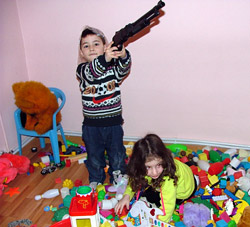 “The children whose parents have not abandoned them and visit them from time to time don't suffer acute psychological trauma. They see their parents but not their home and they assume that this is the way it should be. It's different with children found in the streets who know what a home, an individual family mean. We have a collective upbringing after all. The children are loved ‘in groups'. Of course, the tutors have their ‘favorite kids' but they must love all the children. There is no such thing as not loving here. Such women won't come to work here. The work is hard and the requirements are demanding.
“The children whose parents have not abandoned them and visit them from time to time don't suffer acute psychological trauma. They see their parents but not their home and they assume that this is the way it should be. It's different with children found in the streets who know what a home, an individual family mean. We have a collective upbringing after all. The children are loved ‘in groups'. Of course, the tutors have their ‘favorite kids' but they must love all the children. There is no such thing as not loving here. Such women won't come to work here. The work is hard and the requirements are demanding.
Today we have hot water and gas, but when I took charge of the children's home we didn't have many things, even things like diapers and wet napkins. It has been three years now that the state has been fully financing us. And we have had to buy clothes and toys for a long time – philanthropists provide us with all that,” Karapetyan says.
But however good conditions here are, the children who live in the children's home are behind children who grow up in families. A child in a family is taken care of by a mother, a father, grandparents, and other relatives. Here there is one nanny for ten children.
Every visit is a holiday for the children. And there is no distinction between relatives and strangers for them, whether they are under one year of age or older. They smile at everyone, and are affectionate to everyone, and when they are told that there will be another visit they believe it, remember it, and are prepared to wait.
“What should I bring when I come next time?” I ask.
Malinka approaches me and asks with a timidity that is unusual in her… What would other children ask for – a toy? A chocolate bar?
“Would you give me a hug?” she said.
I hug her. She puts her arms around my neck and cuddles up to me with her warm, little body. They way she would probably hug her mother.
 Videos
Videos Photos
Photos
Comments (1)
Write a comment